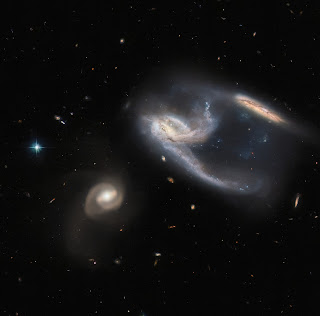A Cosmic Ballet of Three
Comprising NGC 7764A1 (PGC 72755), NGC 7764A2 (PGC 72762), and NGC 7764A3 (PGC 72769), this group showcases a diversity of galactic forms. Each galaxy, with its distinct morphological features, adds a unique flair to the ensemble.
NGC 7764A1: The Unusual Spiral
Starting with NGC 7764A1, we encounter a peculiar spiral galaxy stretching approximately 85,000 light-years across the cosmos. Its spiral structure deviates from the norm, offering a glimpse into the variety that exists within spiral galaxies.
NGC 7764A2: The Grand Spiral Showcase
Next, NGC 7764A2 presents itself as a grand spiral galaxy, dwarfing NGC 7764A1 with a diameter of about 160,000 light-years. Its sprawling spiral arms extend into space, creating a mesmerizing celestial masterpiece.
NGC 7764A3: The Distinguished Lenticular
The trio's final member, NGC 7764A3, introduces a change in pace as a lenticular galaxy. Smaller in size, with a diameter of roughly 50,000 light-years, it lacks the spiral arms of its companions but contributes to the group's diversity with its unique shape.
Beyond Names: The Identity of NGC 7764A
It's crucial not to confuse NGC 7764A with the unrelated spiral galaxy NGC 7764. Despite their similar designations, they are distinct entities, highlighting the sometimes perplexing nature of astronomical nomenclature.
Interstellar Ballet: Tidal Tails and Galactic Mergers
A closer optical examination of NGC 7764A reveals captivating details. NGC 7764A2, for instance, displays tidal tails indicative of gravitational interactions, suggesting a history of cosmic encounters. Similarly, NGC 7764A3's tidal tails, though less conspicuous, hint at its dynamic past.
Interestingly, NGC 7764A2's structure suggests a merger event, supported by high-resolution observations that identify two nuclei within the galaxy. Such phenomena underscore the dynamic and evolving nature of the cosmos.
The Infinite Dance of Galaxies
The study of NGC 7764A not only offers insights into the intricacies of galaxy formation and interaction but also serves as a reminder of the universe's vast and dynamic nature. For enthusiasts, students, and casual observers alike, delving into the stories of galaxies like NGC 7764A enriches our understanding of the cosmos and our place within it.
As we continue to explore and uncover the secrets of the universe, let's not forget the myriad galaxies, each with its own tale, waiting to be discovered. So, the next time you gaze up at the night sky, remember the cosmic dance of galaxies like NGC 7764A, and perhaps, feel inspired to learn more about the incredible universe we inhabit.
Image: Composite optical image of NGC 7764A taken with the Hubble Space Telescope. It was created using broadband optical filters that are centred at 474 nm (G-band, blue), 606 nm (V-band), 644 nm (R-band, green), and 919 (Z-band, red). In this high-resolution image, NGC 7764A dominates the field. NGC 7764A3 is the single galaxy, NGC 7764A2 is the largest, and NGC 7764A3 is its close companion.
Image Credit: ESA/Hubble & NASA, J. Dalcanton, Dark Energy Survey, DOE, FNAL, DECam, CTIO, NOIRLab/NSF/AURA, ES. Acknowledgement: J. Schmidt


Post a Comment